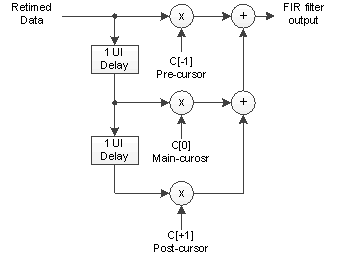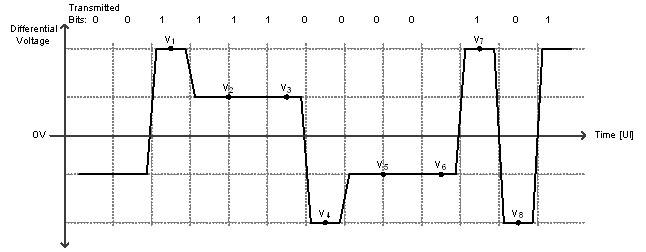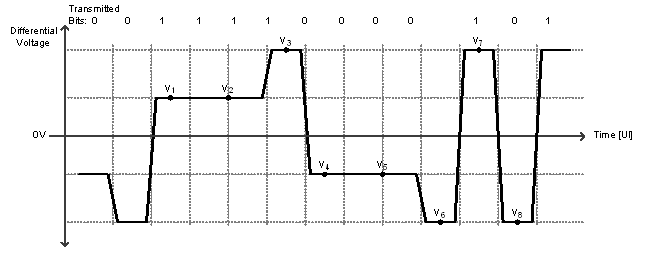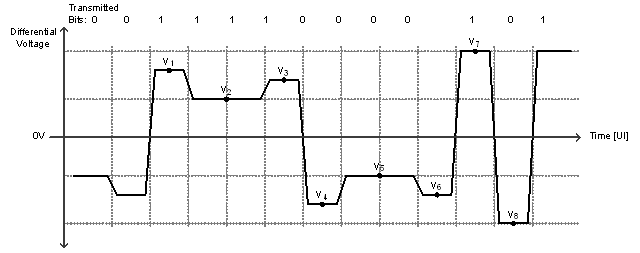ZHCSME1C August 2018 – June 2021 DS250DF230
PRODUCTION DATA
- 1 特性
- 2 应用
- 3 说明
- 4 Revision History
- 5 说明(续)
- 6 Pin Configuration and Functions
- 7 Specifications
-
8 Detailed Description
- 8.1 Overview
- 8.2 Functional Block Diagram
- 8.3
Feature Description
- 8.3.1 Device Data Path Operation
- 8.3.2 Signal Detect
- 8.3.3 Continuous Time Linear Equalizer (CTLE)
- 8.3.4 Variable Gain Amplifier (VGA)
- 8.3.5 Cross-Point Switch
- 8.3.6 Decision Feedback Equalizer (DFE)
- 8.3.7 Clock and Data Recovery (CDR)
- 8.3.8 Calibration Clock
- 8.3.9 Differential Driver With FIR Filter
- 8.3.10 Debug Features
- 8.3.11 Interrupt Signals
- 8.4 Device Functional Modes
- 8.5 Programming
- 8.6 Register Maps
- 9 Application and Implementation
- 10Power Supply Recommendations
- 11Layout
- 12Device and Documentation Support
- 13Electrostatic Discharge Caution
- 14术语表
- 15Mechanical, Packaging, and Orderable Information
封装选项
机械数据 (封装 | 引脚)
散热焊盘机械数据 (封装 | 引脚)
- RTV|32
订购信息
8.3.9 Differential Driver With FIR Filter
The DS250DF230 output driver has a three-tap finite impulse response (FIR) filter which allows for pre- and post-cursor equalization to compensate for a wide variety of output channel media. The filter consists of a weighted sum of three consecutive retimed bits as shown in Figure 8-1. C[0] can take on values in the range [-31, +31]. C[-1] and C[+1] can take on values in the range [-15, 15].
 Figure 8-1 FIR Filter Functional model
Figure 8-1 FIR Filter Functional modelWhen using the FIR filter, it is important to abide by these general rules:
- |C[-1]| + |C[0]| + |C[+1]| ≤ 31; the FIR tap coefficients absolute sum must be less or equal to 31
- sgn(C[-1]) = sgn(C[+1]) ≠ sgn(C[0]), for high-pass filter effect; the sign for the pre-cursor and/or post-cursor tap must be different from main-cursor tap to realize boost effect
- sgn(C[-1]) = sgn(C[+1]) = sgn(C[0]), for low-pass filter effect; the sign for the pre-cursor and/or post-cursor tap must be equal to the main-cursor tap to realize attenuation effect
The FIR filter is used to pre-distort the transmitted waveform to compensate for frequency-dependant loss in the output channel. The most common way of pre-distorting the signal is to accentuate the transitions and de-emphasize the non-transitions. The bit before a transition is accentuated through the pre-cursor tap, and the bit after the transition is accentuated through the post-cursor tap. The waveforms in Figure 8-2 through Figure 8-4 give a conceptual illustration of how the FIR filter affects the output waveform. These characteristics can be derived from the example waveforms:
- VODpk-pk= v7 – v8
- VODlow-frequency = v2 – v5
- RpredB = 20 × log10 (v3 ⁄v2 )
- RpstdB = 20 × log10 (v1 ⁄v2 )
 Figure 8-2 Conceptual FIR Waveform With Post-Cursor Only
Figure 8-2 Conceptual FIR Waveform With Post-Cursor Only Figure 8-3 Conceptual FIR Waveform With Pre-Cursor Only
Figure 8-3 Conceptual FIR Waveform With Pre-Cursor Only Figure 8-4 Conceptual FIR Waveform With Both Pre- and Post-Cursor
Figure 8-4 Conceptual FIR Waveform With Both Pre- and Post-Cursor